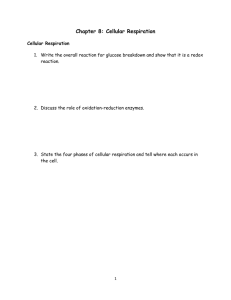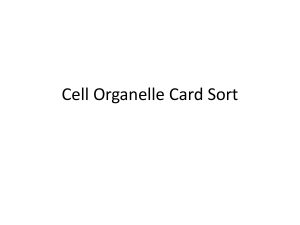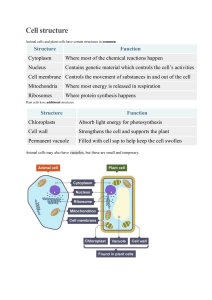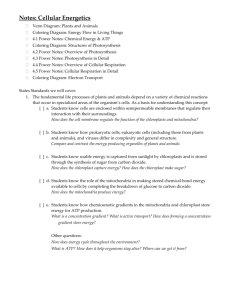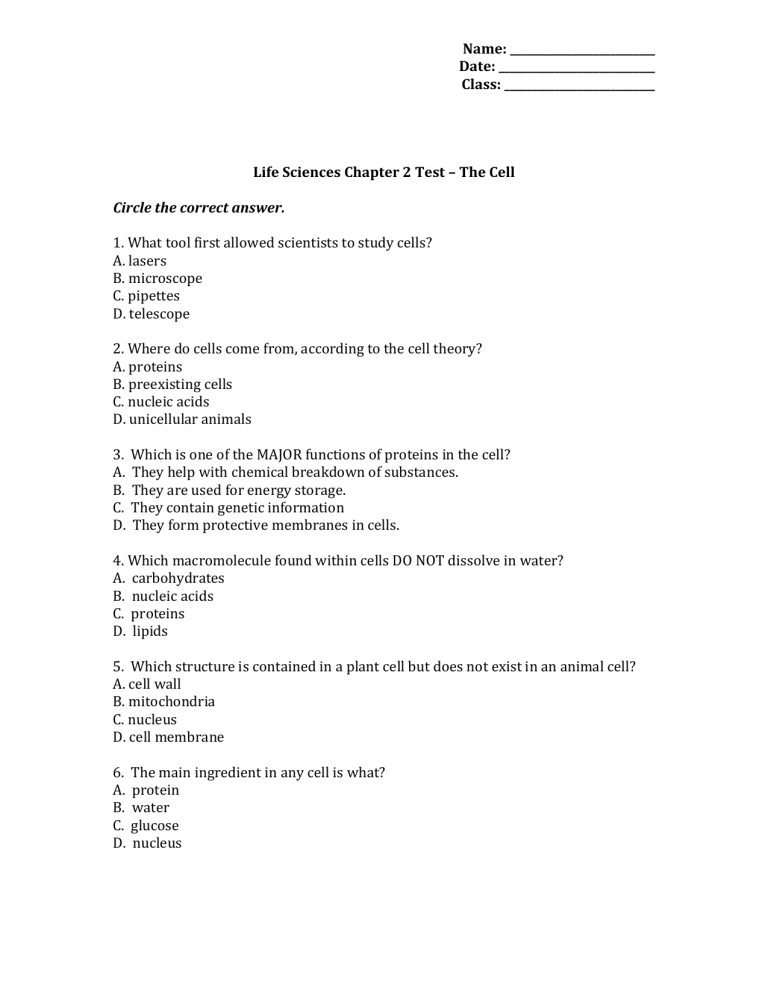
Name: __________________________ Date: ____________________________ Class: ___________________________ Life Sciences Chapter 2 Test – The Cell Circle the correct answer. 1. What tool first allowed scientists to study cells? A. lasers B. microscope C. pipettes D. telescope 2. Where do cells come from, according to the cell theory? A. proteins B. preexisting cells C. nucleic acids D. unicellular animals 3. A. B. C. D. Which is one of the MAJOR functions of proteins in the cell? They help with chemical breakdown of substances. They are used for energy storage. They contain genetic information They form protective membranes in cells. 4. Which macromolecule found within cells DO NOT dissolve in water? A. carbohydrates B. nucleic acids C. proteins D. lipids 5. Which structure is contained in a plant cell but does not exist in an animal cell? A. cell wall B. mitochondria C. nucleus D. cell membrane 6. A. B. C. D. The main ingredient in any cell is what? protein water glucose nucleus 7. A. B. C. D. What organelle in eukaryotic cells directs all the cell activity? chloroplasts Golgi apparatus mitochondria nucleus 8. What type of molecule is produced at the Rough Endoplasmic Reticulum (Rough ER)? A. DNA B. lipids C. proteins D. glucose 9. The movement of substances through a cell membrane using only the cell’s energy is called what? A. endocytosis B. active transport C. facilitated diffusion D. osmosis 10. If a substance is too large to enter through a cell membrane the cell will use the active transport known as what? A. endocytosis B. passive transport C. an elevator D. exocytosis 11. During diffusion, a passive transport process, particles move from an area of __________________ to an area of _____________________. A. smaller molecules, larger molecules B. lower concentration, higher concentration C. higher concentration, lower concentration D. lower pressure, higher pressure 12. The process that breaks down glucose is called what? A. fermentation B. glycolysis C. photosynthesis D. mitochondria 13. What is the desired product of BOTH cellular respiration and fermentation? A. water B. lactic acid C. ATP D. carbon dioxide 14. What is the energy source that powers photosynthesis? A. the Sun B. glucose C. chloroplast D. ATP 15. What is the FIRST step of cellular respiration? A. fermentation B. photosynthesis C. osmosis D. glycolysis 16. In which part of the plant cell absorbs light energy for photosynthesis? A. chloroplast B. mitochondria C. nucleus D. cell wall 17. Glucose is another word for sugar, what is another word for fat? A. protein B. lipid C. carbohydrate D. ATP 18. If your sister were a cellular organelle, which one would she likely be? A. cytoplasm B. mitochondria C. vacuole D. lysosome 19. What are the 2 types of fermentation? A. lipid & glucose B. endocytosis & exocytosis C. carbond dioxide & oxygen D. alcohol & lactic acid 20. Fermentation occurs when oxygen levels are low and, like glycolysis, takes place where in the cell? A. mitochondria B. vacuole C. cytoplasm D. cell wall Complete the following equations that represent Photosynthesis and Cellular Respiration: Photosynthesis: Carbon Dioxide + _______ ---sunlight--- Sugar + ________ Cellular Respiration: Sugar + __________ ------_______+ Carbon Dioxide + ATP Match the cellular organelle to its function within the cell. A. Nucleus B. Mitochondria C. Vacuole D. Cell Membrane E. Cell Wall F. Cytoplasm G. Chloroplast ________25. In ALL cells. Protects the inside of the cell. ________26. Fluid inside the cell that contains other molecules ________27. Stiff structure outside of the cell membrane. Only in plant cells. ________28. Directs cell activities & contains genetic information. ________29. Uses light energy to make food. Only in plant cells. ________30. Store food, water and waste material. ________31. The site of energy production for the cell. ANSWER KEY 1. B 2. B 3. A 4. D 5. A 6. B 7. D 8. C 9. B 10. A 11. C 12. B 13. C 14. A 15. D 16. A 17. B 18. B (Answers may vary) 19. D 20. C 21. WATER 22. OXYGEN 23. OXYGEN 24. WATER 25. D 26. F 27. E 28. A 29. G 30. C 31. B


